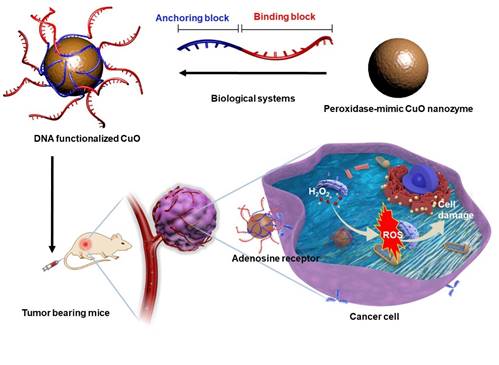Recently, a team led by Professors Ding Jinsong and Zhou Wenhu from Xiangya School of Pharmaceutical Sciences, CSU published its latest study titled “Polarity Control of DNA Adsorption Enabling Surface Functionalization of CuO Nanozyme for Targeted Tumor Therapy” inMaterials Horizons, an authoritative journal in the field of materials. This study reveals the mechanism of absorption and a general pattern of the interaction between DNA and the copper oxide (CuO) nanozyme. Based on this, a DNA sequence was rationally designed to realize controllable surface functionalization of the CuO nanozyme with DNA for tumor targeted therapy.

Controllable surface functionalization of the CuO nanozyme with DNA realized tumor targeted therapy
Nanoenzymes are nanomaterial with enzymatic activity and those with peroxidase activity can catalyze H2O2to produce highly toxic hydroxyl radicals (OH) to induce tumor cell apoptosis, making them a research hotspot in the field of tumor treatment. Inin vivoapplications, nanoenzymes need to be modified to enhance their high-efficiency, low-toxicity delivery for tumor targeted therapy. However, it is still a big challenge to quickly modify the surface of nanozymes with targeting ligands without affecting enzymatic activity. The team has been engaged in research on DNA and its interaction with nanomaterials for a long time. Based on the preliminary research, this study systematically explored the mechanism and stability of DNA adsorption on the surface of the CuO nanozyme, and found that a DNA fragment composed of the bases T and C was highly stably absorbed onto the surface of the CuO nanoenzyme to resist desorption by biological matrices. Thus, a diblock DNA sequence was rationally designed to stably absorb DNA onto the CuO surface via the bases T and C, and the free DNA end can specifically recognize the adenosine receptors on the tumor cell membrane surface to realize thein vivostable transport of the CuO nanozyme, targeted tumor identification and highly selective tumor treatment. This study is the first to elucidate a pattern of the interaction between DNA and the surface of the CuO nanozyme and its antitumor mechanism based on peroxidase activity, providing a new idea for the functional modification of nanozymes.
It was reported that this study was a completely independent work of the team members, with Dr. Meng Yingcai from Xiangya School of Pharmaceutical Sciences as the first author, Professor Zhou Wenhu as the corresponding author of the paper, and CSU as the first corresponding affiliation. This study was supported by the National Natural Science Foundation of China (NSFC).
Source: Xiangya School of Pharmaceutical Sciences
